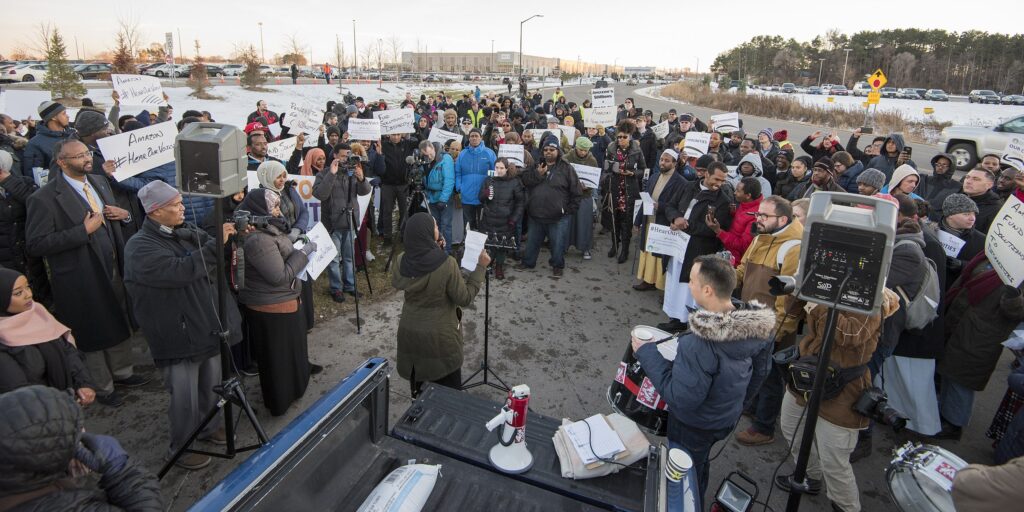Amazon workers deserve better
Diana Enriquez / Dec 16, 2021Diana Enríquez is a PhD Candidate in Sociology at Princeton University.
Last week a deadly tornado hit an Amazon warehouse in Edwardsville, Illinois and killed at least six workers. What we know about the situation in Edwardsville is evolving, but the facts are concerning:
- Workers at the facility indicated that restrictions on access to personal cell phones may have hindered awareness of the severe weather conditions, even as Amazon executives denied the prohibition.
- There was initial confusion over just how many people were even at the facility, because contract workers were not accounted for in the same way as regular employees.
- Responding to the disaster, employees at other Amazon facilities expressed concerns that the company did not provide adequate emergency training.
- Some experts raised whether the structure of the building was safe given the threats of more intense storms, as stories about employees huddled in bathrooms emerged, and even of some who were forbidden to leave the facility.
- The Occupational Safety and Health Administration (OSHA) announced it would investigate whether enough was done to protect workers.
While the tragedy points to the ongoing plight of all Amazon workers, it puts a particular focus on the contract and gig workers who have fewer workplace protections than regular employees. And, it puts a spotlight on efforts to organize workers to demand more protections, and the obstacles to doing so.
An Army of Contractors With Few Protections
A substantial percentage of the workers at Edwardsville and in many other Amazon facilities-- particularly at the peak of the holiday season-- are contractors, which means they have fewer workplace protections. Amazon as a marketplace is so successful because it creates a seamless experience for consumers who think of something they want to buy, type it into search in a single marketplace place, and then can expect it to arrive at their door within a handful of days. To keep costs low and adaptive, Amazon and other gig work platforms hire thousands of contract workers to fulfill roles in warehouses and delivery programs.
Consider Amazon Flex, a program which hires contract delivery workers into 2-4 hour paid blocks of time. Contractors hired through the program are typically barred from working more than 40 hours at the site. This prevents these workers from crossing the legal boundary into “full-time employee” status, which comes with legal protections that are currently not available to most part-time and contract workers. When a worker accepts these temporary contracts, they are expected to weigh their own risks before they accept the job. Most people are not equipped to assess the full extent of the risk they accept on a contractor job role, because this kind of position is ambiguous and frequently evolving.

Working in a warehouse is not an easy job. It often requires carrying heavy objects for long periods of time, spending most of the day on your feet, and dodging forklifts and other heavy machinery that moves even heavier objects around the warehouse. Employees are eligible for compensation if they are injured. Gig workers and contractors are often explicitly not covered by workplace injury compensation policies.
The contract for gig work typically looks more like a “terms and service” agreement than an agreement between an employer seeking a stable relationship with a healthy team and a worker. Platforms like Amazon and Uber rely on a large pool of workers they can call upon to make sure someone is available any time there is a need for a service request to be filled quickly. Despite the large number of jobs offered by these platforms, there is no guarantee these jobs will provide enough income to cover even the basic operating costs for the worker completing the task using their own cars and equipment.
While some specific damages are covered in the typical contract (for example, Uber drivers receive some support for repairs if a passenger damages their vehicle during the trip), other kinds of workplace injuries and damages are not covered. Further, workers are punished when they reject a job offered to them or need to cancel when something goes wrong. While a platform has many tools for trying to control workers, there is very little infrastructure for the often isolated, individual worker to keep the platform accountable. Unless the workers build the infrastructure themselves.
Overcoming the Obstacles to Organizing in the Gig Economy
Organizers who want to address unsafe workplace conditions are forced to do so in an increasingly hostile legal environment. While there are several significant obstacles in their path, organizers within the gig economy must make progress in addressing the needs of of workers, including in these three key areas:
Addressing the ambiguity of contractor roles. When I asked contract Amazon and Uber drivers in my own fieldwork how they categorize their jobs, they variously described themselves as a “freelancer,” “contractor,” and even “employee,” even when they were not. The ambiguity is marketed as an opportunity by these platforms-- consider Amazon’s efforts to encourage its delivery drivers to form their own LLCs and companies, which was a deliberate effort to distance the delivery driver from the regular Amazon workforce so that Amazon could decrease its liabilities with these workers. When the term and its treatment is so ambiguous and varies so much by workplace, it’s very difficult for workers to collectively imagine who else is “on their team” and what they could collectively do to improve their working environment.
A major challenge for contract workers who are organizing to address their working conditions is the enforcement of anti-trust laws against contract worker unions. The Federal Trade Commission is revisiting how the laws have been enforced and looking for ways that contract worker unions, like traditional unions, can be exempt. Gig workers highlight all the ways they are employees, but their ambiguous categorization makes it difficult for them to unionize.

Building an understanding of the benefits of unions. There is skepticism about the impact and benefits of unions, even among contract and gig workers. The gains made by more robust unions in the past are taken for granted. We find ourselves now seeing what the cost of weakened unions looks like for many workers. But increasingly, workers in part-time and low paying positions are becoming aware of how much American labor law has fractured under weakening unions as they try to negotiate their schedules between several part-time jobs with “just in time” scheduling. Sociologists find that this kind of unstable scheduling limits income and damages not only relationships within families, but each workers’ overall health and well being.
Several Amazon warehouses teams have brought unionization to a vote, some successfully and others unsuccessfully. After decades of anti-union speeches by politicians, Right-To-Work laws, and a renewed “fear of socialism” in the United States, even historically successful unionization strategies and tools might not be enough to gain new members. The drivers I’ve interviewed for my research present a mix of opinions about their status as workers and how they feel about unionization efforts. All of them, however, mentioned places where they saw other contract workers building a sense of community and trying to support each other even when they had limited contact.
Indeed, organizers in the gig economy are using a mix of traditional and newer tools to address the problems they’ve identified and raise awareness of the benefits of organizing. The Gig Workers Collective uses the specific stories workers share about their experiences to expose some universal truths about the challenges gig workers face in their isolated positions working for platforms. These stories- shared on social media- serve to build a broader sense of community among isolated workers and help encourage them to organize within their local communities. The texture they provide is especially important as consumer expectations shift towards increasingly shorter windows for deliveries, which creates dangerous conditions for drivers who are expected to meet these unreasonable conditions or face bad ratings and deactivation. This platform also frequently appeals to consumers even as it offers resources for organizers and critiques of existing policy models by platforms.
"Yes, it was a freak accident, but the facts are still that these workers were making sure my dog gets a Frisbee -- tomorrow -- and gave their life for it. It seems really kind of ridiculous when you think about what the stakes are." Beth Gutelius, research director at the Center for Urban Economic Development at the University of Illinois-Chicago, speaking to the Associated Press on the Edwardsville Amazon warehouse collapse
Explaining impacts on workers up and down the supply chain. Amazon is one the few companies that have expanded to the point that they are able to set the terms for workers at other firms around them in the supply chain. As one example of this, Amazon is now such a powerful employer that it managed to make the USPS deliver on Sundays using (often) non-unionized members of the USPS delivery service. Indeed, these platform companies are so powerful that there are signs their behaviors are shifting the fundamental relationship between employers, consumers, and workers. When we add in the layers of automated management into the relationship, the workers are increasingly distanced from the powerful designs implemented by the platform and the demands presented by the consumers.
What’s more, the very ideas that platform companies propagate about how to manage their human resources are having an impact on the broader labor force. Executives at platform companies like Amazon and Uber have helped shape our understanding of “the future of work.” When we give them the exclusive opportunity to build this narrative, we contribute to the creation of more environments like the Amazon warehouses and the isolated, unstable conditions workers at Uber and other platforms face. The current model for “independent contractor” is not inevitable. It is designed- including by executives who admire what Amazon has been able to accomplish.
Consumers must change their expectations, too
Workers and organizers must work hard to change the balance of power with companies like Amazon. But change also requires an honest conversation about the expectations of consumers and a government willing to acknowledge and address the unsustainable patterns unleashed by unrealistic expectations.
Putting aside for a moment an extreme disaster like the one in Edwardsville, the holiday season is already especially demanding on workers in Amazon warehouses and on its delivery routes. Rage about the supply chain and the inconveniences of the pandemic are compounded at this time of year, when the company relaxes its under-40 hour scheduling policies for contractors and brings on numerous seasonal workers to address the escalating consumer demand. This year drivers described the pressure after Black Friday as crushing. Even when consumers order from the Amazon marketplace at the very last minute, they get angry when their exact demands cannot be met in the way they are during the rest of the year. The contractors and workers in the Illinois warehouse were there late into the evening trying to handle the demands of the season.
It’s time to talk to the workers and ask them to describe what is and is not doable in this period of the already strained supply chain. It is time to ask workers what work should realistically look like: to have a clear and consent-driven conversation about risk, rather than a coercive one where workers are forced to face bodily harm during a natural disaster or risk losing their jobs or paychecks. When we talk about “the future of work,” we’ve typically left the workers who hold the complicated system together out of the design process. The tragedy in Edwardsville exposes the damage caused by a system that is focused on writing workers out of the discussion entirely.
For more on Diana Enríquez's research, listen to her September interview on the Tech Policy Press podcast.
Authors
